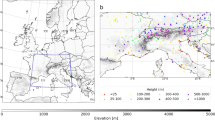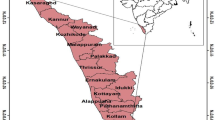Abstract
The present study analyses the possible change in the seasonal prediction skill of El Nino Southern Oscillation (ENSO) in association with the reported climate modification in the tropical Pacific during the early twenty-first century. Both the boreal summer (JJAS) and winter (DJF) seasons ENSO hindcasts from nine models that participated in the National Multi-model Ensemble Project (NMME) for the period 1981–2019/20 are used in the study. The analysis shows that after 2000 (period 2), all the models have reduced interannual variability as observations (for both 4-month and 1-month lead hindcasts or ICs) for both the target seasons. But the loss of skill during that period is mainly confined to the JJAS season. This JJAS season ENSO skill loss for Feb IC (4-month lead) during the second period is more for CanSIPSv2, CCSM3, and NEMO model hindcasts, while it is least for CCSM4. The same is increased for three GFDL models after 2000, initialised using Feb IC. It is observed that during the second period, proper representation of initial month SST anomalies (ie, February month for 4-month lead and May month for 1-month lead hindcasts) in the north Atlantic (NA) play a major role in the evolution of ENSO during summer. During the first period (1981–2000), the NA SST warming (cooling) was associated with divergence (convergence) and central Pacific cooling (warming) similar to central Pacific ENSO. Meanwhile, during the second period, the NA SST anomalies are confined to the Atlantic by summer, and the central Pacific SST anomalies extend further eastward. Most of the model hindcasts, mainly initialized during February are not able to capture the NA SST pattern during pre-monsoon and the co-occurred ENSO events. The models with better or close to observe patterns for Atlantic SST induced ENSO is only able to maintain the same skill as previous decades.








Similar content being viewed by others
Data availability
All the observed data sets used are available online downloadable from ECMWF (atmospheric variables) https://www.ecmwf.int/en/forecasts/datasets/reanalysis-datasets/era5., HadISST from https://www.metoffice.gov.uk/hadobs/hadisst/data/download.html and model outputs from http://iridl.ldeo.columbia.edu/SOURCES/.Models/.NMME/.
Code availability
Not applicable.
References
Ashok K, Behera S, Rao AS, Weng H, Yamagata T (2007) El Niño Modoki and its teleconnection. J Geophys Res 112:C11007. https://doi.org/10.1029/2006JC003798
Balmaseda M, Anderson D, Vidard A (2007) Impact of Argo on analyses of the global ocean. Geophys Res Lett 34:L16605. https://doi.org/10.1029/2007GL030452
Balmaseda M, Mogensen K, Weaver A (2013) Evaluation of the ECMWF ocean reanalysis ORAS4. Q J R Meteorol Soc 139:1132–1161. https://doi.org/10.1002/qj.2063
Barnston AG, Tippett MK, L’Heureux ML et al (2012) Skill of real-time seasonal ENSO model predictions during 2002–11: Is our capability increasing? Bull Am Meteorol Soc 93:631–651. https://doi.org/10.1175/BAMS-D-11-00111.1
Choi J, An SI, Yeh SW (2011) Decadal amplitude modulation of two types of ENSO and its relationship with the mean state. Clim Dyn 38:1–14
Chung P-H, Li T (2013) Interdecadal relationship between the mean state and El Niño types. J Clim 26:361–379. https://doi.org/10.1175/JCLI-D-12-00106.1
Feng MM, McPhaden J, Lee T (2010) Decadal variability of the Pacific subtropical cells and their influence on the southeast Indian Ocean. Geophys Res Lett 37:L09606. https://doi.org/10.1029/2010GL042796
Ham YG, Kug JS, Park JY (2013a) Two district roles of Atlantic SSTs in ENSO variability: North Tropical Atlantic SST and Atlantic Nino. Geophys Res Lett 40:4012–4017
Ham YG, Kug JS, Park JY, Jin FF (2013b) Sea surface temperature in the north tropical Atlantic as a trigger for El Niño/Southern Oscillation events. Nat Geosci 6:112–116. https://doi.org/10.1038/ngeo1686
Hendon HH, Lim E, Wang G, Alves O, Hudson D (2009) Prospects for predicting two flavors of El Niño. Geophys Res Lett 36:L19713
Hersbach H et al (2020) The ERA5 global reanalysis. Q J R Meteorol Soci 146:1999–2049
Hu Z-Z, Kumar A, Ren H-L, Wang H, Heureux ML, Jin FF (2013) Weakened interannual variability in the tropical Pacific Ocean after 2000. J Climate 26:2601–2613. https://doi.org/10.1175/JCLI-D-12-00265.1
Izumo T et al (2016) A simple estimation of equatorial Pacific response from wind stress to untangle Indian Ocean dipole and basin influences on El Niño. Clim Dyn 46(7–8):2247–2268. https://doi.org/10.1007/s00382-015-2700-4
Jin F-F (1997) An equatorial ocean recharge paradigm for ENSO. Part I: Conceptual model. J Atmos Sci 54:811–829. https://doi.org/10.1175/1520-0469(1997)054%3c0811:AEORPF%3e2.0.CO;2
Kirtman BP, Schopf PS (1998) Decadal variability in ENSO predictability and prediction. J Clim 11:2804–2822. https://doi.org/10.1175/1520-0442(1998)011%3c2804:DVIEPA%3e2.0.CO;2
Kirtman BP et al (2014) The North American multimodel ensemble. Bull Am Meteorol Soc 95:585–601
Kleeman R (2002) Measuring dynamical prediction utility using relative entropy. J Atmos Sci 59:2057–2072
Kug J-S, Kang I-S (2006) Interactive feedback between the Indian Ocean and ENSO. J Clim 19:1784–1801
Kumar A, Chen M, Xue Y, Behringer D (2015) An analysis of the temporal evaluation of ENSO prediction skill in the context of equatorial Pacific Ocean observing system. Mon Weather Rev 143:3204–3213. https://doi.org/10.1175/MWR-D-15-0035.1
Luo J-J, Zhang R, Behera SK, Mastumoto Y, Jin FF, Lukas R, Yamagata T (2010) Interaction between El Niño and extreme Indian Ocean dipole. J Clim 23:726–742
Luo J-J, Sasaki W, Masumoto Y (2012) Indian Ocean warming modulates Pacific climate change. Proc Natl Acad Sci USA 109(18):701–718. https://doi.org/10.1073/pnas.1210239109 (706)
McPhaden MJ (2012) A 21st-century shift in the relationship between ENSO SST and warm water volume anomalies. Geophys Res Lett 39:L09706. https://doi.org/10.1029/2012GL051826
McPhaden MJ, Zebiak SE, Glantz MH (2006) ENSO as an integrating concept in Earth science. Science 314:1740–1745. https://doi.org/10.1126/science.1132588
McPhaden MJ, Lee T, McClurg D (2011) El Niño and its relationship to changing background conditions in the tropical Pacific Ocean. Geophys Res Lett 38:L15709. https://doi.org/10.1029/2011GL048275
Pillai PA, Rao SA, George G, Rao DN, Mahapatra S, Rajeevan M, Dhakate A, Salunke K (2017) How distinct are flavors of El Nino in retrospective forecasts of climate forecast system version2(CFSv2)? Clim Dyn 48:3829–3854
Pillai PA, Rao SA, Das RS, Salunke K, Dhakate A (2018) Potential predictability and actual skill of Boreal Summer Tropical SST and Indian summer monsoon rainfall in CFSv2-T382: Role of initial SST and teleconnections. Clim Dyn 51:493–510
Rayner NA et al (2003) Global analyses of sea surface temperature, sea ice, and night marine air temperature since the late nineteenth century. J Geophys Res 108:4407. https://doi.org/10.1029/2002JD002670,D14
Rodriguez-Fonseca B, Polo I, Gracie-Serrano J, Losada T, Mohino E, Mechoso CR, Fl K (2009) Are Atlantic Niños enhancing Pacific ENSO events in recent decades? Geophys Res Lett 36:L20705
Saha S et al (2014) The NCEP Climate Forecast System version 2. J Clim 27:2185–2208. https://doi.org/10.1175/JCLI-D-12-00823.1
Wang C, Kucharski F, Barimalala R, Bracco A (2009) Teleconnections of the tropical Atlantic to the tropical Indian and Pacific Oceans: a review of recent findings. Meteorol Z 18:445–454
Wen C, Kumar A, Xue X, McPhaden MJ (2014) Changes in tropical Pacific thermocline depth and their relationship to ENSO after 1999. J Clim 27:7230–7249. https://doi.org/10.1175/JCLI-D-13-00518.1
Xiang B, Wang B, Li T (2013) A new paradigm for the predominance of standing central Pacific warming after the late 1990s. Climate Dyn 41:327–340. https://doi.org/10.1007/s00382-012-1427-8
Zhao M, Hendon H, Alves O, Yin YH, Anderson D (2013) Impact of salinity constraints on the simulated mean state and variability in a coupled seasonal forecast model. Mon Weather Rev 141:388–402. https://doi.org/10.1175/MWR-D-11-00341.1
Zhao M, Hendon H, Alves O, Yin YH (2014) Impact of improved assimilation of temperature and salinity for coupled model seasonal forecasts. Clim Dyn 42:2565–2583. https://doi.org/10.1007/s00382-014-2081-0
Acknowledgements
Authors are thankful to Prof. Ravi S. Nanjundiah, Director, Indian Institute of Tropical Meteorology (IITM), and Dr. Suryachandra A Rao, Program manager, Monsoon Mission, IITM for encouraging to carry out this research work. The IITM is fully funded by the Ministry of Earth Sciences, Government of India. All the figures are prepared using GrADS software freely available from http://cola.gmu.edu/grads/. The editor and the two anomalous reviewers are acknowledged for their constructive comments.
Funding
Authors have no funding information.
Author information
Authors and Affiliations
Contributions
PAP: conceptualisation, Formal analysis, supervision, methodology and validation., writing-original, reviewing, and editing. ARD: validation, software, writing-corrections, and editing.
Corresponding author
Ethics declarations
Conflict of interest
The authors have no conflicts of interest to declare.
Ethics approval
Not applicable.
Consent to participate:
Not applicable.
Consent to publish
Not applicable.
Additional information
Publisher's Note
Springer Nature remains neutral with regard to jurisdictional claims in published maps and institutional affiliations.
Rights and permissions
About this article
Cite this article
Pillai, P.A., Dhakate, A.R. Role of Atlantic SST anomalies in the recent ENSO predictability change in NMME model hindcasts. Clim Dyn 59, 3683–3699 (2022). https://doi.org/10.1007/s00382-022-06290-5
Received:
Accepted:
Published:
Issue Date:
DOI: https://doi.org/10.1007/s00382-022-06290-5




